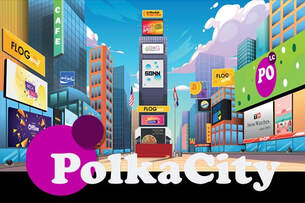 https://www.silvermanphoto.com/nxnl is the link to the joint exhibition with Joel Liss Silverman and Claire A, Warden. Joel and Claire are both skilled photographers, with different yet intriguing work. I hope you'll visit our site. Polka City can be downloaded at https://www.polkacity.io/, and there's information there regarding the Polka City metaverse. Polka City also has Twitter & Telegram. To benefit from play to earn games and get apy & rewards from owning Polka City NFT's, you'll need the cryptocurrency Polc. Polc can be bought by setting up a Binance USA account, then sending BNB to Metamask and swapping it for Polc. Metamask can be downloaded at https://metamask.io/ If you want to get involved in the metaverse but need help with any of the steps please email me, I'll help. Week 5 blog post, MFA 5630
0 Comments
Interview with a conceptual artist, Michelle Renee Hoppe, and a fiber artist, Jennifer Lord7/8/2022 I interviewed Michelle Renee Hoppe, an excellent artist, whose site can be seen at https://www.michellereneehoppe.co/studio and Jennifer Lord, also very talented, whose website is at https://juniperlord.com/studio-process-blog/
Michelle's art has many deeper meanings and relates back to her life, and yet has a sense of playfulness, in her giant colorful fuzzy stuffed spiders, and poetry. There is both a freedom and intelligence in her work that is both ethereal and yet invites one to spend time with it. Jennifer's studio is beautiful, with her hanging fabric collages of different sizes and shapes, with a plethora of patterns and textures. Her work radiates creativity and femininity, because of her unique and novel choices along with the floral patterns. The interviews are transcribed below. If you'd like to watch them, the video links are: https://www.dropbox.com/s/zqe5po7ejc9sv49/IMG_0399.MOV?dl=0 https://www.dropbox.com/s/ayswyugy79a1t8c/IMG_0400.MOV?dl=0 https://www.dropbox.com/s/6tqay6mzslbcscl/IMG_0398.MOV?dl=0 If the video link is cut and pasted to the search bar, it'll play. I tested this on the Chrome browser. My apologies for the poor video quality, I planned to have audio only but wasn't sure how to turn off my cell phone video. One of the videos is an unfortunate extended close up of my lap & I didn't mean for that to happen. The phone was intended to remain upside down and then I started talking with my hands while holding my phone. I'd wanted audio only so readers of this blog would listen only to our words and how we talked about our art, and then form images in their minds from our words, then visit our studio blogs to see what we create to either be surprised by or to have their mental images confirmed. To have the experience I tried to create, please listen without watching. Jennifer interview: Ann Marie asked about the multiple patterns and textures. Jennifer said she was excited about using a variety of patterns and textures, but still wanted harmony and cohesion. She aligns her work with cosmological principles, health, balance and regeneration. She wanted to show how differences can coexist in a beneficial way. Ann Marie then asked about the military style camo patten. Jennifer talked about the significance and historical meaning, as well as the cultural baggage. She said she was still learning, and knew it was a loaded patten. Michelle then asked Jennifer about the doily, that was various shades of green. Jennifer intended it to be multicolored, and Michelle thought it might be camo. Jennifer said she was interested in lace and nets, and she discussed how crochet can't be mechanized. She felt that dying it incorporated it into the language of the work. Ann Marie asked Jennifer about the significance of the floral patterns, and if they related to femininity. Jennifer said she was a feminist, femme presenting, living in a patriarchal society, and that she was inspired by previous generations of female artists. She felt that sewing as well was traditional in Western culture, and that the floral was part of the language. She enjoys working with transparent fabric, and forms as well. In response to Michelle commenting on the different flowers, Jennifer used the term "esthetic network" in how paintings of flowers, and vases worked together. Michelle interview: Jennifer noted that Michelle both writes and creates objects, and Michelle agreed. Jennifer asked what being a "conceptual artist" meant to her, and Michelle said that writing was conceptual, as was collaboration, that how one works with others is part of the art, because it is part of the conceptualization. Michelle felt that treating her collaborators fairly was important, because it was a gift, and that she wants her collaborators to benefit. She discussed how she treated those who help her, that she pays them and gives them a percentage of her sales. Jennifer asked about her process, and Michelle said we are in a reaction economy, not an intention economy. She wants to hit an "emotional trigger" for people. She relies on intuition, not the obedience form of logic, and discussed how Descartes inspired her. Michelle feels that we have a behavioral science problem in the USA, that we make medicines that our people can't afford, and that 80% of movies have violence against women, and that the USA is an exporter of extremist ideology. She mentioned that even our stories of empowerment become stories of subjugation. Michelle said that her practice was very political, partly as a response to her family being so prominent in the Republican Party and Mormon Church. Michelle talked about her work having a "dark playfulness", and that good humor was dark. Ann Marie commented on Michelle's combination of politics and art, then specifically asked about a poem that Michelle wrote on the wall in large violet and gold letters and asked what it was about. It was the first poem that Michelle wrote, in second grade in Utah. She got in trouble because of it, that she was medicalized, and grew up in an unfriendly environment. The poem was impactful in her development because as a result she was given an IQ test, and was then left alone more to work on her poetry and art. Ann Marie then asked about the meaning of the stuffed spiders and web. Michelle described her process and how she was inspired by uncanny valleys and Etsy, where she saw an image. Ann Marie interview: Jennifer asked about the vases, and how the two paintings present, a bluejay with flowers and a floral painting, related to the vases. Ann Marie explained how the vases showed the beauty of the art that the creator of the Waterford vase made, and that a flower could still be brought back into it, in the vase. Jennifer asked about the motivation in showing someone elses creation. Ann Marie said she wanted to show the beauty of the world, whether it was natural or created by others, and that both are beautiful. Jennifer said that she felt that beauty increased our capacity to care, and to experience the interconnection we have with other beings and life systems. Michelle asked about my use of mood, in that the blue jay looked unfriendly and was "dead eying" the viewer, and she appreciated the use of a subtle negative mood on top of a peaceful, joyful floral background. Ann Marie commented on how blue jays weren't particularly friendly, and that you would wait a long time if you went to the park to hold one, that they lived their whole lives without relying on us. That even if we put a bird feeder out, that they don't connect that to humans or thank us. Ann Marie said she wanted to paint how blue jays truly are, beautiful but not relying on humans. Jennifer asked about the process of painting the floral painting, and Ann Marie said she was inspired by photos, and that they were real flower varieties. Ann Marie wanted to create a natural arrangement of flowers and how they could grow in the wild, and how it was put together. Michelle said she felt it was sculptural and that it was balanced. Ann Marie described how she painted the vines first and then painted circularly. Michelle asked if Ann Marie could paint a huge one, and Ann Marie was hesitant, unsure of her technical skill and endurance since the small one took three weeks, but that she might try someday. Jennifer noted that Ann Marie said she wanted to paint photo realistically, but that it seemed a little impressionistic, and how Ann Marie painted. Jennifer asked about how Ann Marie saw color, and Ann Marie explained how she changed from day to day, week to week, and that there were days when she wanted to do details and felt capable of it, and that there were other days when her mood was different. Ann Marie said her next painting might be a geode. MFA 5630 Week 3 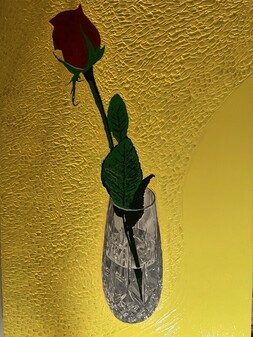 Part 1: I studio by making sure I’m physically comfortable, enough sleep the night before, that I’ve had some healthy food, and that I’m not too cold or too hot. I’ve also got to be wearing something comfortable, sweatpants and a t-shirt are frequently chosen. Clothes that I wouldn’t be bothered by getting a few splotches of paint on. The early morning is best for me, and my times are usually roughly scheduled, not to the minute, but that I know I’m going to paint that morning. On a particular studio day I decide what I'd like to paint, and mentally decide where certain parts of it will be on the canvas. Starting with the vase, I make sure I have all the colors I’ll need, usually an assortment of grays, along with radiant white and titanium white. Linseed oil and turpentine, along with all my detail brushes. I’d place a little of each color I plan to use on a palette, maybe 1/8th of an inch of each, and fill two wells, one with turpentine and the other with linseed oil. Working relatively quickly, going back and forth between the two darkest grays, a medium and medium light gray, I’d paint the dark shadows. Then I’d clean my brush and move between a light gray and a light gray/white mixture (to create a very light gray) I’d paint more detail and fill in areas. Then I’d clean my brush again and add pure white highlights. It would be roughly eight inches tall, and three inches wide, and would take about ninety minutes to paint. By the end of that ninety minutes, my hand would be a little sore and my eyes would be tired. I focus in on the vase, on its form, and highlights. Nothing else enters my mind, and the ninety minutes passes as if it were only one. Yet when the time is done, and the vase is complete, I feel the full weight of the passed time in my sore hand and tired eyes. The flowers and background will need to wait for another day. Part 2: I’m working on a painting of a red rose in a crystal vase on a yellow background. A typical day for me is to wake up at around 7 a.m., make sure Sakura cat has food, start coffee, eat breakfast, drink coffee, and check my phone for the news, usually yahoo.com and msn.com. Then I’ll paint for a while, have lunch, take a nap/do some shopping/chores, eat dinner, watch a movie, and go to sleep. I don’t consider myself a professional artist. I’ve only sold a few things, the last one being about 17 years ago. Yes. The painting I was working on was still very, very wet, there wasn’t any way I could bring it without it being ruined, and the next step requires the yellow to be completely dry. I’m planning on painting the ground the vase will sit on purple, which means I need to paint the ground white, then purple (so the yellow doesn’t show through the purple, that would give it a muddy brown cast, since purple + yellow together create brown). Week 2, MFA 5630 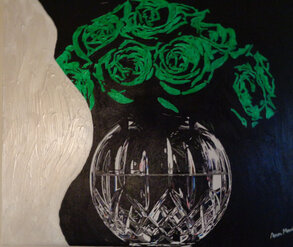 For me, to practice means to improve my technique. For much of my work, my goal is to be able to paint skillfully enough that the images might have been taken by a camera, particularly in respect to the crystal vases I prefer to place my flowers in, or in natural flower arrangements. I don’t want the viewer to be distracted by my painting, or for the natural beauty of the flower to be diminished by my not portraying it accurately. Nature is beautiful in real life, and therefore a genuine representation (to show the beauty of God’s creation) is my goal. To be professional means to do my best to paint accurately, to take my time, gather the right materials, clean my brushes so they’ll be in top condition the next time I want to paint. I also want to explore with new tools and new ways of painting, and I’ve been inspired by the art of other students in my cohort. Before I left home, I filled a cookie sheet with Elmer’s glue after lining it with parchment paper, swirled some acrylic paint and then left it to dry. When I left it had been drying for a few weeks but wasn’t dry (the glue is a thick layer), but the glue seems to be contracting much more than the paint. The purity of color and random forms were starting to be attractive and interesting. I’m not sure where I’m going with this random project, and I’m excited to see what it will look like when I get home. Not nearly as excited as I am to be here, of course, but I can’t wait to see it. Perhaps I’ll cut up my glue and acrylic sheet, rearrange it, or sculpt with it. It's final form will depend on how pliable it ends up being. The Covid lockdowns have given me more alone time, and thus more space and time to work on my art, to think, and to simply “be”. The increased time has improved my own personal innovation, and was responsible for my application to SAIC, because I had more time to create the work needed for a portfolio. Other than more space and time, and my SAIC application, it hasn’t opened new avenues for me to share my art with other people. I created a website, but then deleted it. I listed my art on Amazon handmade and Etsy, then delisted them. I didn’t think anyone was looking at my website, and thought it was just another small automatic debit, and that those add up. The same with Etsy, just a small automatic debit with no results. I’ve spent time sending emails to galleries, carefully curating numerous images that I think match the existing art in their gallery, with no response. The lack of response has been a little disheartening, I truly don’t know what they’re looking for. I know many galleries rely on personal connections, and I don’t know how to create them from scratch without an email. If they don’t respond, then, I’m at a loss. Standing around galleries or visiting in the hope they will speak to me seems alternately odd or awkward. Yes, “professional” has meaning for my work, because of my constant efforts to improve, and “practice” does as well, as I’ve never created a piece of art that I’m truly satisfied with. I’ve never painted anything where there isn’t something about it that I’m not satisfied with, or don’t see as needing improvement. Therefore “professional practice” is an accurate description of what I endeavor to do. Week 1, MFA 5630-001 |
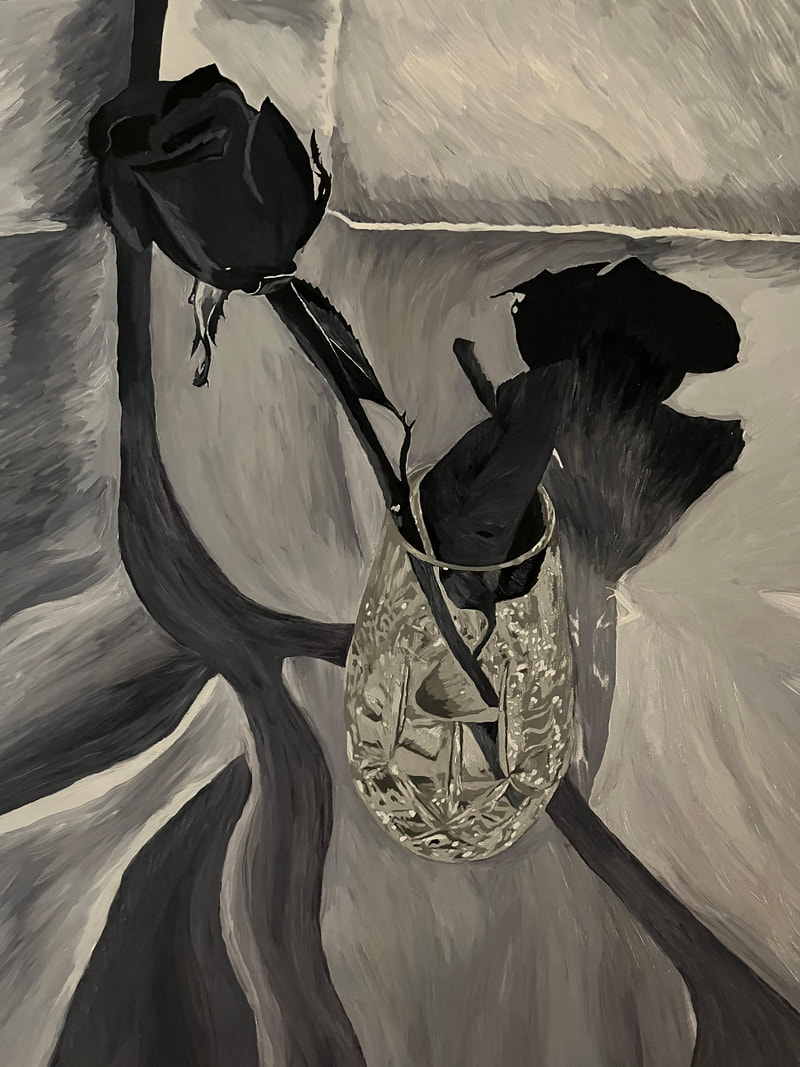
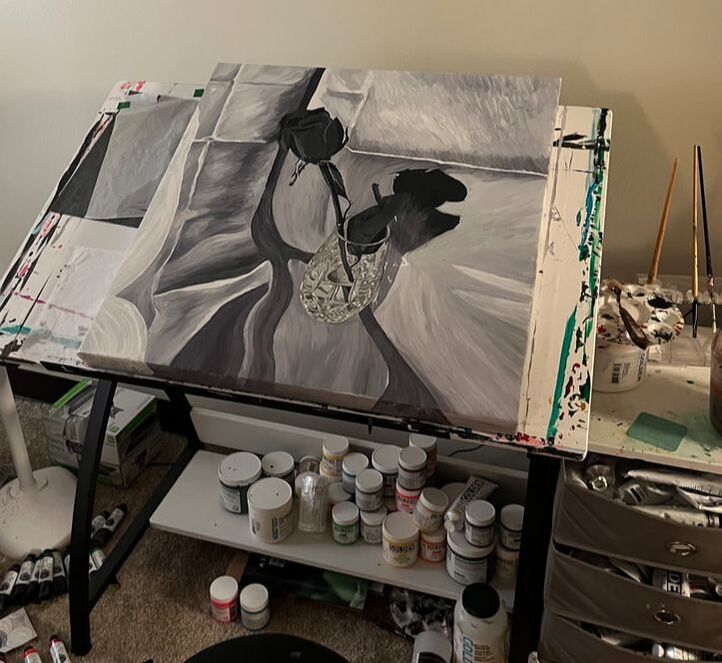
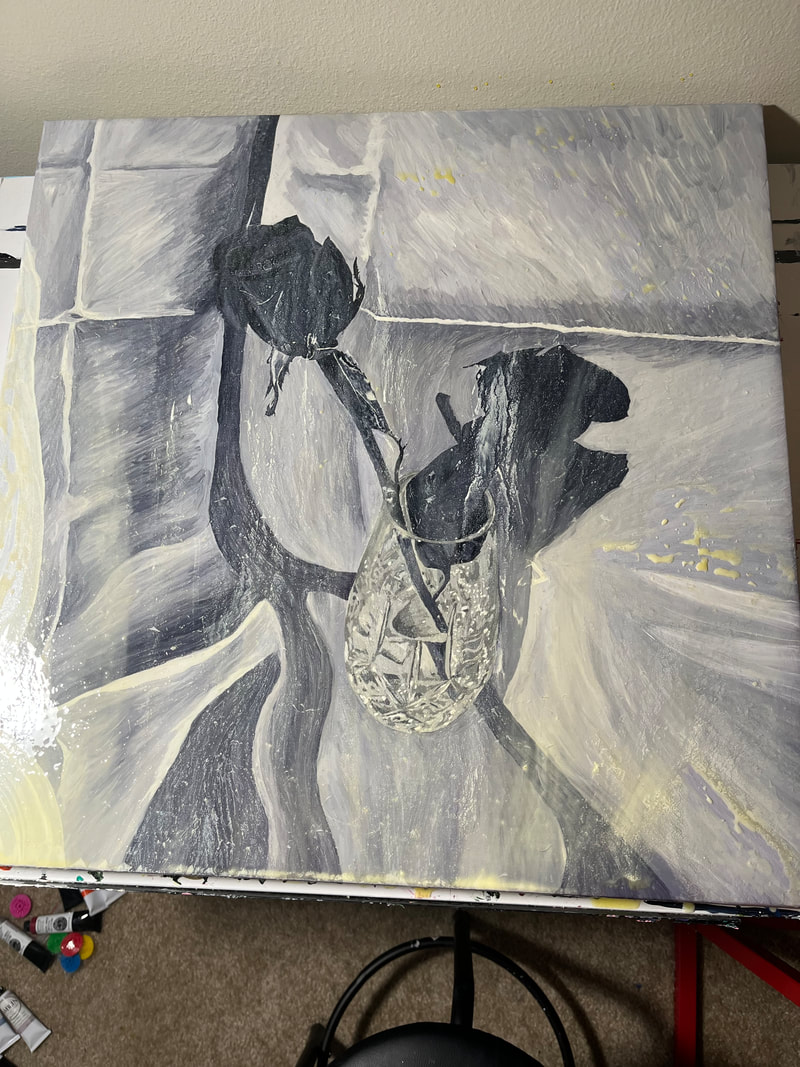
 RSS Feed
RSS Feed
